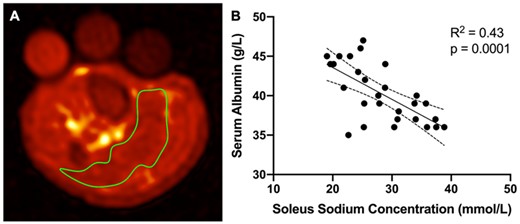-
PDF
- Split View
-
Views
-
Cite
Cite
Fabio Salerno, Alireza Akbari, Sandrine Lemoine, Justin Dorie, Tanya Tamasi, Christopher McIntyre, SO027
ASSOCIATIONS OF MUSCLE SODIUM DEPOSITION WITH SODIUM-23 MRI IN HEMODIALYSIS PATIENTS, Nephrology Dialysis Transplantation, Volume 35, Issue Supplement_3, June 2020, gfaa139.SO027, https://doi.org/10.1093/ndt/gfaa139.SO027Close - Share Icon Share
Abstract
The development of sodium-23 magnetic resonance imaging (23Na MRI) allows the clinical quantification of tissue sodium. Recent studies have shown that hemodialysis (HD) patients have a tendency to retain tissue sodium due to impaired mechanisms in local tissue sodium clearance. However, the clinical significance of tissue sodium deposition in the HD patient population is unclear yet. The aim of this study was to investigate the association of tissue sodium deposition with well-established biomarkers of clinical outcomes.
Chronic, thrice weekly HD patients underwent 23Na MRI of the leg on a non-dialysis day, during either the long or short interdialytic interval. Blood samples were also taken for the measurement of standard blood-based biomarkers. A multinuclear-capable 3.0-T MRI (GE Healthcare, Milwaukee WI) was used to acquire proton and sodium images. Maps of tissue 23Na concentration were generated using an in-house software developed within MATLAB (Mathworks, Natick, USA, R2018a). 23Na concentration maps were superimposed with the proton-anatomy images to delineate the regions of interest. Using the Horos (The Horos Project, Version 4.0.0) software, the soleus muscle was segmented (Figure, Panel A) and the sodium concentration in the region of interest was recorded for analysis.
28 HD patients completed both 23Na MRI and bloodwork; 7/28 (25%) patients were females; mean±SD age was 66.1±8.3 years, mean body mass index was 30.9±6.5 kg/m2, and mean HD vintage was 30.2±34.9 months. Soleus muscle sodium concentration showed a strong, negative correlation with serum albumin (Figure, Panel B; r=-0.66, p<0.0001). Furthermore, soleus muscle sodium concentration showed a minor association with plasma hemoglobin (r=-0.46, p=0.01).
Serum albumin is a recognized, powerful predictor of mortality in the hemodialysis patient population. The strong relationship between muscle sodium concentration and serum albumin levels suggests that tissue sodium deposition may be a relevant biomarker of clinical outcomes. In addition, muscle sodium deposition may be involved in the development of anemia. These findings warrant further studies investigating the consequences of sodium removal on these biomarkers.

Figure: Panel A: sample 23Na MRI image with soleus muscle region of interest (in green). Panel B: linear regression fit of soleus sodium concentration vs serum albumin (95% confidence interval bands).





Comments